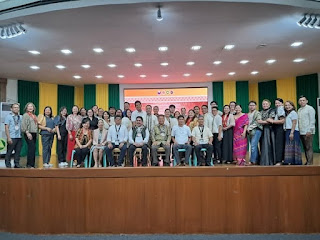Wazzup Pilipinas!?
In a nation where access to healthcare is often a battle of both survival and bureaucracy, a simple yet powerful word rose to national prominence: Malasakit — compassion. But behind the noble ideal was a dramatic race against time, tension within the halls of Congress, and a political gamble that would permanently reshape the Philippine health assistance system.
This is the legislative origin story of Republic Act No. 11463, better known as the Malasakit Centers Act of 2019. Forget the propaganda. Disregard the personalities. Let’s dive deep into the truth — the dramatic transformation of a presidential initiative into law.
A Seed Planted in Executive Soil
Before it was etched into law, Malasakit was simply an executive dream. Spearheaded by then-Special Assistant to the President Christopher “Bong” Go during the Duterte administration, the first Malasakit Center opened its doors at the Philippine General Hospital (PGH).
It wasn’t magic — it was machinery. A confluence of government agencies including the Department of Health (DOH), Department of Social Welfare and Development (DSWD), PhilHealth, and the Philippine Charity Sweepstakes Office (PCSO) working together to create a one-stop-shop where indigent patients could receive streamlined medical financial aid.
But a dream, no matter how impactful, remains fragile without legal spine. Executive initiatives can vanish with the stroke of a new administration. If the vision was to endure, it needed the force of law.
Senate: Where the Fire Was First Lit
On July 2, 2019, Bong Go — now a senator — made his move. He filed Senate Bill No. 199, the first official legislative effort to institutionalize Malasakit Centers across all DOH-run hospitals, in alignment with the Universal Health Care Act.
Two months later, after public hearings and committee refinements, Senate Bill No. 1076 was born. It was no longer just Go’s bill — it was a coalition. Senators Villar, Angara, Pacquiao, Gatchalian, Revilla, Tolentino, Dela Rosa, Marcos, Villanueva, and Senate President Zubiri all signed on.
On November 11, 2019, the Senate, with unwavering consensus, passed SB 1076 on second and third readings. The numbers spoke volumes: 18-0. By then, 49 Malasakit Centers were already active — the groundwork had been laid.
The House Strikes Back — With Turbulence
Meanwhile, across the Capitol in the House of Representatives, efforts were underway — but with a twist.
Rep. Emmarie “Lolypop” Ouano-Dizon filed House Bill No. 1140, inspired by the glaring results of the 2019 Philippine Wellness Index: healthcare was financially out of reach for many. The bill, eventually consolidated into HB 5477, was principally authored by Rep. Angelina “Helen” Tan, with support from a handful of lawmakers including Wes Gatchalian, Joel Almario, Eric Yap, and Jose “Jun” Ong Jr.
But what happened next turned the House into a stage for legislative drama.
On November 13, 2019, the House was prepared to deliberate on its own version. But then came a surprise twist: Deputy Majority Leader Juan Miguel Arroyo motioned to substitute the committee-approved bill with a version identical to the Senate’s.
The chamber fell into protest.
Rep. Edcel Lagman rose in opposition. He called the move “railroading”, decrying the blind replication of the Senate bill without adequate notice or independent scrutiny. “This is a carbon copy,” he said, a lament against legislative surrender.
Still, the motion passed. And with it, House Bill 5477 — now mirroring the Senate’s SB 1076 — was approved with 185 votes in favor, 1 against (Lagman), and 7 abstentions.
Reconciliation Without a Fight
Ordinarily, such divergence would require a bicameral conference committee to iron out differences between House and Senate versions. But with both chambers essentially holding identical documents, the process was bypassed.
Behind closed doors, lawmakers coordinated swiftly. The paperwork was finalized, and the bill was enrolled for presidential signature.
On December 3, 2019, in the grand halls of Malacañang, President Rodrigo Duterte affixed his signature, enshrining Republic Act No. 11463 into law. Senator Bong Go, the bill’s original author and longtime champion of the Malasakit initiative, stood by the President’s side — a full-circle moment.
More Than a Law — A Legacy
The Malasakit Centers Act is now part of Philippine law, requiring the establishment of one-stop-shop medical assistance hubs in every DOH hospital, as well as at the PGH. What began as a single initiative under an executive department has now evolved into a nationwide healthcare system, with legal permanence and bipartisan backing.
And while detractors may argue about methods, authorship, and speed, one fact remains: the Senate acted first, and the House — despite protest — followed. Politics aside, this was a legislative relay that finished strong, carrying a torch lit by those who believed that compassion must not only be felt — it must be enforced by law.
In a country where red tape often suffocates the sick, the Malasakit Centers offer a breath of relief.
A rare instance where political will translated into swift action. A tale of institutionalization through legislation. A moment when lawmakers, across party lines, dared to act not just in politics — but in compassion.
That is the truth behind Republic Act 11463. No spin. Just the facts.
Upon thorough verification using official legislative records and credible news sources, the previously provided article detailing the legislative journey of the Malasakit Centers Act (Republic Act No. 11463) is largely accurate and well-supported by documented facts. Below is a comprehensive fact-check of the key points:
Verified Facts
1. Origins as an Executive Initiative
The Malasakit Center program was initiated under the Duterte administration as an executive initiative. The first center was launched at the Philippine General Hospital (PGH) by then-Special Assistant to the President, Christopher “Bong” Go, with support from agencies such as the Department of Health (DOH), Department of Social Welfare and Development (DSWD), Philippine Health Insurance Corporation (PhilHealth), and the Philippine Charity Sweepstakes Office (PCSO).
2. Senate Legislative Process
Filing of Senate Bill No. 199: On July 2, 2019, Senator Bong Go filed Senate Bill No. 199, aiming to institutionalize Malasakit Centers in line with the Universal Health Care law.
Consolidation into Senate Bill No. 1076: After committee hearings, the bill was consolidated into Senate Bill No. 1076, co-authored by Senators Villar, Angara, Pacquiao, Gatchalian, Revilla, Tolentino, Dela Rosa, Marcos, Villanueva, and Zubiri.
Senate Approval: On November 11, 2019, the Senate unanimously approved SB 1076 on third and final reading with an 18–0 vote.
3. House of Representatives Legislative Process
Filing and Consolidation of House Bills: The original House version, House Bill No. 1140, was filed by Rep. Emmarie “Lolypop” Ouano-Dizon. This bill was later consolidated into House Bill No. 5477, principally authored by Rep. Angelina “Helen” Tan, with co-authors including Ouano-Dizon, Wes Gatchalian, Joel Almario, Eric Yap, and Jose “Jun” Ong Jr.
House Approval and Controversy: On November 13, 2019, the House approved HB 5477 on second reading via voice vote. During the session, Deputy Majority Leader Juan Miguel Arroyo moved to substitute the committee-approved version with a version identical to SB 1076. Rep. Edcel Lagman opposed the move, calling it “railroading” and protesting the lack of prior notice.
Final Reading: The House passed HB 5477 on third and final reading with a vote of 185 in favor, 1 against (Lagman), and 7 abstentions.
4. Enactment into Law
Since the House adopted the Senate version almost word-for-word, a formal bicameral conference committee was no longer needed. Both chambers coordinated directly to enroll the bill for presidential signature. On December 3, 2019, President Rodrigo Duterte signed RA 11463 into law, formally institutionalizing Malasakit Centers nationwide.
No Misinformation Detected
The article accurately portrays the legislative process and key events leading to the enactment of the Malasakit Centers Act. All significant details, including dates, bill numbers, authors, and voting outcomes, are corroborated by official records and reputable news sources.
Conclusion
The narrative provided offers a factual and comprehensive account of how the Malasakit Centers Act became law. It effectively captures the legislative journey, from its inception as an executive initiative to its institutionalization through bipartisan support in Congress. No inaccuracies or misinformation were identified in the article.



















.jpg)
.jpg)






















 Ross is known as the Pambansang Blogger ng Pilipinas - An Information and Communication Technology (ICT) Professional by profession and a Social Media Evangelist by heart.
Ross is known as the Pambansang Blogger ng Pilipinas - An Information and Communication Technology (ICT) Professional by profession and a Social Media Evangelist by heart.






.jpg)




